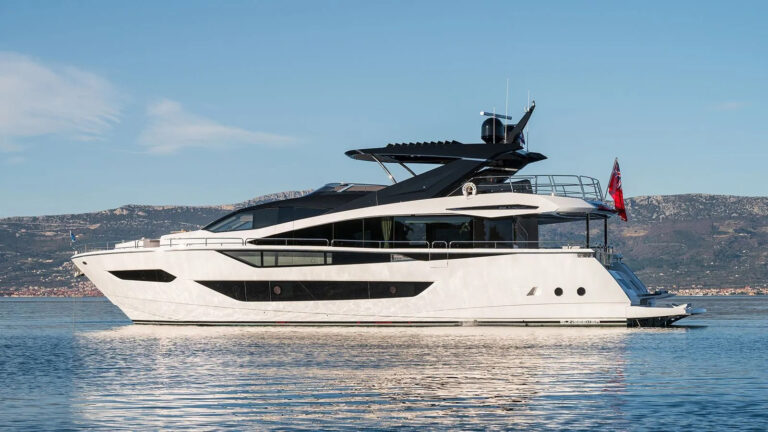
Infiniti 100 S
Architect Walter Gropius founded the Bauhaus school at Weimar, Germany, in 1919, and 24 years later, under the direction of Ludwig Mies van der Rohe, it closed. Spawned by the German modernism movement of the 1880s, the rational, functional and radically simplified forms of the Bauhaus continue to influence industrial designers, architects and naval architects. The Infiniti 100 S, drawn by Hugh Welbourn, fits perfectly within the Bauhaus discipline, but a captivating innovation — maybe more important than the aesthetics — lurks beneath the waterline.
Welbourn designed this Infiniti for a client who wanted a very fast cruising yacht that he’d sail most of the time in the Med — blow high, blow low. She had to be stylish and have loads of space topside for the owner and guests to relax, swim and enjoy the experience of sailing. Yes, he’d race the yacht, but he didn’t want that to be her main reason for being. Nor would it be extended cruising. The accommodations would house six guests in three staterooms forward of amidships and four crew members in two cabins aft.
An ultramodern design of this type won’t please everyone. The Infiniti’s sharp entry, plumb stem, chine visible just above the waterline in the after sections and hard edges of the reverse transom slap you across the face, instead of hugging you. On the other hand, the gradual transition from the vertical topsides forward to a graceful flare abaft the deckhouse should reassure you that the slap was purely to get your attention. The subtle spring in her sheer line also softens the blow and may help traditionalists appreciate the excellence of this design, even if they can’t love it.
In stark contrast to the severe angles of the hull, the deckhouse rises like an orca’s forehead from a sea of teak. This conceptual rendering suggests that the house is made of smoked tempered glass or Lexan, but the portside elevation reveals the faint outline of a long and thin window in the side of the house. Infiniti Yachts wasn’t ready to release many details at this writing, but I’ll guess that the final design will have a composite structure, maybe painted black or a dark, smoky gray. Notwithstanding the rounded contours of the deckhouse, its presence barely softens the overall businesslike demeanor of the Infiniti 100. After all, a boulder sculpted by a swiftly flowing river may have an equally soft-edge shape, but you still wouldn’t want to cuddle it.
Don’t expect to discover any relief from this yacht’s intimidating presence when you peer below the waterline. Her fine U-shape sections forward transition to a relatively shallow arc bottom aft, which meets the topsides in a sharp chine of the type you’ll find on a Volvo 70 racing yacht, for example. Although naval architects disagree about the benefits of chine hulls, most accept that a well-designed example planes more easily, and stays on plane for a longer period of time, than does a hull with rounded bilges; i.e. no chine. The consensus among designers also states that the chine should be kept out of the water when the boat heels to a breeze.
Chine-hull yachts also have to be light enough to plane, and at a displacement of 66,000 pounds, this one is. Infiniti predicts that the 100 will sail at 20 knots, or faster, on a reach, which equals a speed/length ratio of nearly 2.00, instead of the more common 1.34. An increase in wetted surface area and the subsequent reduction in light-air performance are the compromises this type of hull demands, but that’s a small price to pay for an exhilerating top speed.
A ballast bulb, shaped like a super-streamline torpedo, hangs from the tip of a deep, high-aspect fin keel. An equally high-aspect rudder steers the yacht. The high lift-to-drag ratio of each appendage fits the boat’s potential for high speeds, but they may stall easily at the low speeds achieved when she sails in light air. The helmsman will have to be attentive.
So far we see nothing new here, I admit, but the yacht has a third foil — this one dedicated to reducing heel and pitch and damping motion, which can be uncomfortable when the yacht sails upwind in heavy seas. Developed by Welbourn’s Dynamic Stability Systems (www.dynamicstabilitysystems.com), this foil lives athwartships in a slot molded into the boat’s bottom. Its location and thickness keep it from intruding on the accommodations. The foil deploys to leeward, and its hydrodynamic shape counteracts the heeling force of the sails. The effect is similar to that of water ballast or a canting keel, but without the complicated engineering. On a cruising boat, the crew and guests may appreciate the foil’s ability to reduce pitch and roll as much or more than the reduction in heeling angle.
Aboard relatively small yachts, the crew operates a single foil via line and tackle. Aboard large yachts, a hydraulic mechanism deploys and retrieves a separate foil on each side. Fully deployed, the foil extends about the same distance outboard of the yacht’s bottom, as does a canting keel.
Welbourn’s testing has proved the effectiveness of Dynamic Stability Systems and its ease of operation aboard a small boat, and I have no reason to believe that it won’t function perfectly aboard the Infiniti 100 S. If you want to amaze your sailing buddies and dominate the talk at the yacht club bar, you couldn’t find a more compelling design to build. I can’t wait to sail her.
LOA: 98’5″
Beam: 20’4″
Draft: 14’9″(lifting keel option under consideration)
Displ.: 66,000 lb.
Yachtzoo, +377-9770-5200, 954-767-1035; www.yacht-zoo.com









